
Erechtites hieraciifolius is a plant in the daisy family, Asteraceae. It is native to the Americas, but is found many places around the world having been introduced by human activity. It is introduced in Hawaii, China, and Southeast Asia.
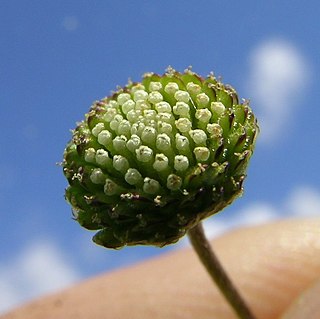
Cotula australis is a species of plant in the daisy family known by the common names bachelor's buttons, annual buttonweed, southern waterbuttons and Australian waterbuttons. This small plant is native to Australia and New Zealand, but it is known in other areas of the world as a common weed.

Bidens laevis is a species of flowering plant in the daisy family known by the common names larger bur-marigold and smooth beggarticks. It is native to South America, Mexico, and the southern and eastern United States. It grows in wetlands, including estuaries and riverbanks.
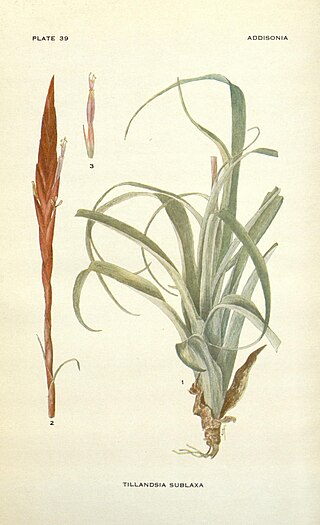
Tillandsia variabilis, the leatherleaf airplant, is a species of bromeliad in the genus Tillandsia. This species is native to Bolivia, Costa Rica, Mexico, Venezuela, Colombia, the West Indies and southern Florida.
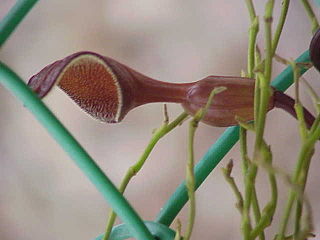
Aristolochia maxima is a plant species native to Central and South America, naturalized in southern Florida. Common names include Florida Dutchman's-pipe (US), canastilla (Guatemala), guaco, and tecolotillo (Mexico). In Florida, it grows in hammocks in the Everglades at elevations below 50 m.
Spermacoce glabra, smooth false buttonweed, is a New World species of plants in the coffee family.
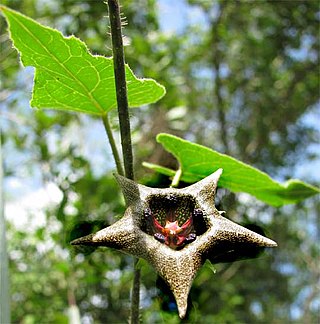
Dictyanthus is a genus of plant in family Apocynaceae, first described as a genus in 1844. It is native to Mexico and Central America.
Brickellia glandulosa is a Mesoamerican species of flowering plants in the family Asteraceae. It is widespread from San Luis Potosí south to Nicaragua.
Brickellia paniculata is a Mesoamerican species of flowering plant in the family Asteraceae. It is widespread from Tamaulipas west to Sinaloa and south as far as Costa Rica.
Brickellia argyrolepis is a Mesoamerican species of flowering plants in the family Asteraceae. It is native to Central America and to southern Mexico.

Chromolaena ivifolia called ivy-leaf false thoroughwort, or ivyleaf thoroughwort, is a species of flowering shrub in the family Asteraceae. It is native to North America and South America, from the south-eastern United States to Argentina.
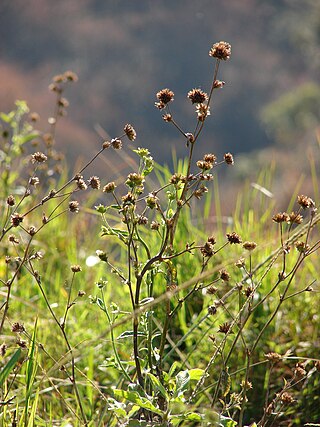
Elephantopus mollis, common names tobacco weed, and soft elephantsfoot, is a tropical species of flowering plant in the family Asteraceae.

Erechtites glomeratus, common name New Zealand fireweed, or cutleaf burnweed, or fireweed or Cluster-headed fireweed, is a species of plant in the sunflower family. It is native to Australia and New Zealand, and also naturalized on the Pacific Coast of the United States.
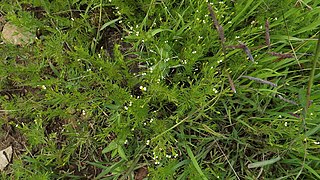
Tagetes filifolia is a New World species of marigolds in the family Asteraceae. It is widespread across much of Latin America from northern Mexico to Argentina. Common name is Irish lace despite the fact that the plant does not grow in Ireland.
Tagetes microglossa is a Mesoamerican species of marigold in the family Asteraceae. It grows in Central America, Colombia, and Ecuador, as well as in central and southern Mexico, from Jalisco to Chiapas.

Gnaphalium polycaulon, the many stem cudweed, is a plant species in the family Asteraceae. It is widespread across much of Mesoamerica, South America, and the West Indies, and naturalized in parts of Asia and Africa.

Hieracium gronovii, commonly known as queendevil, hairy hawkweed, beaked hawkweed, and Gronovius' hawkweed, is a North American plant species in the tribe Cichorieae within the family Asteraceae. It is common and widespread across much of the continent from Ontario south as far as Florida, the Dominican Republic, and Panamá. The plant can be found in rocky, dry, open woods and in fields.

Persicaria hydropiperoides is a New World species of flowering plant in the buckwheat family known by the common names swamp smartweed and false waterpepper. It is widespread across much of North America and South America. It grows in moist and wet habitats, and is sometimes semi-aquatic.
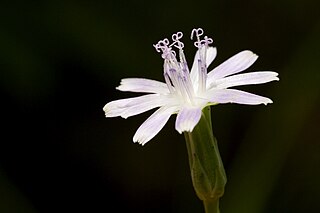
Lactuca graminifolia, the grassleaf lettuce is a North American species of wild lettuce. It grows in Mexico, Central America, Hispaniola, and the southern United States from Arizona to Florida, Virginia and the Carolinas.
Xyris ambigua, the coastal plain yelloweyed grass, is a North American species of flowering plant in the yellow-eyed-grass family. It is native to southern and eastern Mexico, Central America, Cuba, and the southeastern and south-central United States.














